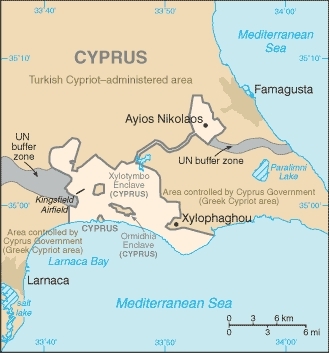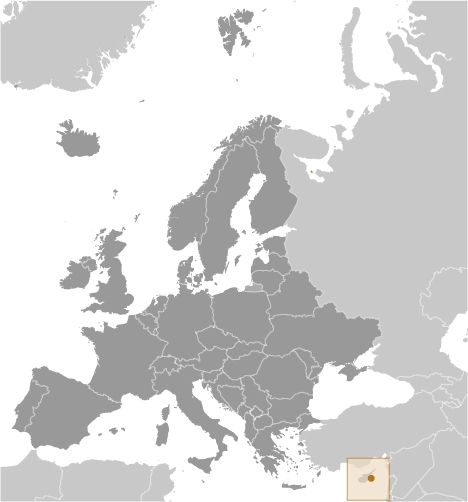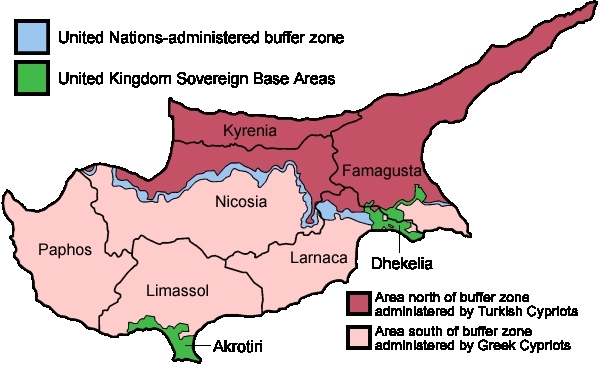Dhekelia
Countries and Regions of the World Collection  Dhekelia is part of the island of Cyprus in the Eastern Mediterranean (Mediterranean Sea), under the sovereignty of the United Kingdom used as a military base.
Dhekelia is part of the island of Cyprus in the Eastern Mediterranean (Mediterranean Sea), under the sovereignty of the United Kingdom used as a military base.
Dhekelia is a special form of UK overseas territory; administered by an administrator who is also the Commander, British Forces Cyprus
Its environmental issues include the netting and trapping of small migrant songbirds in the spring and autumn.
A former British colony, Cyprus became independent in 1960 following years of resistance to British rule.
By terms of the 1960 Treaty of Establishment that created the independent Republic of Cyprus, the UK retained full sovereignty and jurisdiction over two areas of almost 254 square kilometers - Akrotiri and Dhekelia. The larger of these is the Dhekelia Sovereign Base Area, which is also referred to as the Eastern Sovereign Base Area.
British extraterritorial rights also extended to several small off-post sites scattered across Cyprus; of the Sovereign Base Area land 60% is privately owned and farmed, 20% is owned by the Ministry of Defense, and 20% is SBA Crown land
Tensions between the Greek Cypriot majority and Turkish Cypriot minority came to a head in December 1963, when violence broke out in the capital of Nicosia. Despite the deployment of UN peacekeepers in 1964, sporadic intercommunal violence continued forcing most Turkish Cypriots into enclaves throughout the island.
In 1974, a Greek Government-sponsored attempt to seize control of Cyprus was met by military intervention from Turkey, which soon controlled more than a third of the island. In 1983, the Turkish Cypriot-occupied area declared itself the "Turkish Republic of Northern Cyprus" ("TRNC"), but it is recognized only by Turkey.
Geography
Location: Eastern Mediterranean, on the southeast coast of Cyprus near Famagusta
Geographic Coordinates: 34 59 N, 33 45 E
Area: 130.8 sq km Note: area surrounds three Cypriot enclaves
Land Boundaries: 103 km (approximately) with Cyprus
Coastline: 27.5 km
Climate: temperate; Mediterranean with hot, dry summers and cool winters
Population: approximately 15,700 live on the Sovereign Base Areas of Akrotiri and Dhekelia including 7,700 Cypriots, 3,600 service and UK based contract personnel, and 4,400 dependents
Capital: Episkopi Cantonment (base administrative center for Akrotiri and Dhekelia); located in Akrotiri
Legal System: the Sovereign Base Area Administration has its own court system to deal with civil and criminal matters; laws applicable to the Cypriot population are, as far as possible, the same as the laws of the Republic of Cyprus
Economy: Economic activity is limited to providing services to the military and their families located in Dhekelia. All food and manufactured goods must be imported.
Administrative divisions of Cyprus. Source: Golbez/Wikipedia
Ecology and Biodiversity
The Cyprus Mediterranean forests ecoregion covers the island. Located in the Mediterranean Sea, this island ecoregion is home to a variety of flora and fauna. More than 125 endemic plants are found here including the endangered Cyprus cedar (Cedrus brevifolia) and the Cyprus oak (Quercus alnifolia). The island also serves as a stepping stone between Europe and Africa for millions of migratory birds every year. Over 350 species of birds can be found here, most of which are migratory. Some 46 residents and 27 migratory species breed regularly on the island; about 10 species are endemic. The island is home to a number of mammals such as the Cyprus moufflon (Ovis orientalis ophion), which is a rare type of wild sheep found only on the island of Cyprus. Only eighteen percent of the island is covered by its original habitat. Conversion of forest to pastures, urban development, forest fires, and tourism are all causes of habitat loss and continue to be a threat to this ecoregion.
See also: Biological diversity in the Mediterranean Basin and Value of Mediterranean forests


